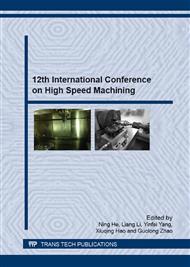p.402
p.408
p.417
p.425
p.430
p.436
p.444
p.452
p.462
Heat Transfer Model for Pulse Laser Assisted Machining of ZrO2
Abstract:
Laser assisted machining (LAM) is one important solution for machining difficult-to-machine materials. The heat transfer model of quasi steady state in laser assisted micro machining is built, and the simulation software for temperature distribution measurement is developed based on MATLAB. The simulated temperature distribution of the ZrO2 ceramic heated by pulse laser shows a good agreement of tendency with the corresponding experimental results through the infrared temperature measurement method, while the simulated temperature is consistently overestimated. This difference maybe results from the neglect of the heat loss caused by the heat radiation and the heat convection in the model. The proposed model in this paper could provide reference for the selection of optimal process parameters and improve the machining quality, which are closely related to the temperature distribution.
Info:
Periodical:
Pages:
430-435
Citation:
Online since:
January 2016
Authors:
Price:
Сopyright:
© 2016 Trans Tech Publications Ltd. All Rights Reserved
Share:
Citation:


